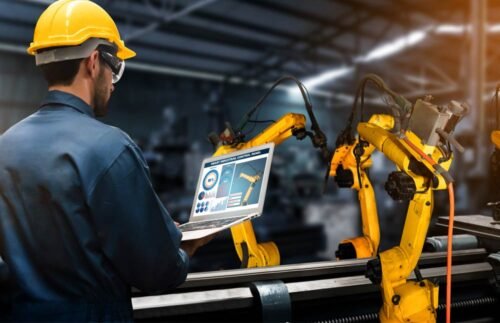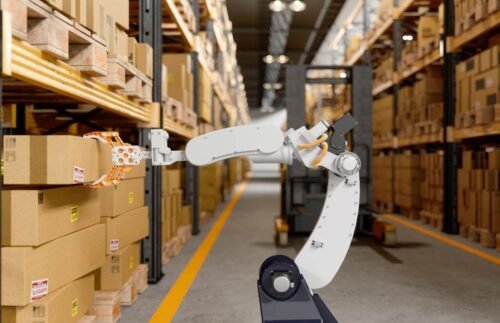How Technology Trends Are Transforming Manufacturing
 Today smart, connected products are transforming the way we live, work, and play. From phones, home appliances, and autonomous vehicles to personal assistants and medical devices—these products are bringing added convenience to our lives and supporting our health and well-being.
Today smart, connected products are transforming the way we live, work, and play. From phones, home appliances, and autonomous vehicles to personal assistants and medical devices—these products are bringing added convenience to our lives and supporting our health and well-being.
Advanced technologies like the Cloud, Internet of Things (IoT), and artificial intelligence (AI) are creating new opportunities for how consumers interact with these smart, connected products and how businesses operate. Manufacturers are especially embracing a digital transformation and turning to these technologies to optimize all aspects of product development—from design and production to supply chain management. In this article, we take a closer look at cloud software systems and other digital technologies that are reshaping the world of manufacturing.
CLOUD COMPUTING
As the global economy becomes more vulnerable to pandemics, material shortages, logistics issues, and other supply chain shocks, manufacturers are leveraging the Cloud to keep dispersed teams connected and enhance transparency. Cloud-based product lifecycle management (PLM) and quality management system (QMS) software solutions enable original equipment manufacturers (OEMs), suppliers, and contract manufacturers to access current product information and collaborate in real time from any location. In turn, these teams can better manage supply chain activities and mitigate issues that impact product launches.
Managing Complex Designs Throughout the Product Lifecycle
To meet customer demand for smarter and more interactive products, manufacturers also need an effective way to manage complex designs throughout the product lifecycle. Cloud PLM and QMS solutions address this need by aggregating mechanical, electrical, and software designs as well as related quality processes into one unified system. With access to a single source of truth, product teams can stay on the same page when it comes to design changes, regulatory requirements, and other factors that are essential to optimizing design for manufacturability (DFM) and ensuring commercialization success.
INTERNET OF THINGS (IOT)
The Internet of Things (IoT) plays a pivotal role in helping manufacturers gather valuable insights on the production process as well as customer or end-user experience.
By employing a network of embedded sensors and cloud technology, IoT enables manufacturers to gather real-time data on equipment malfunctions, workflow issues, and other factory floor inefficiencies. Detecting these issues early on helps manufacturers avoid costly downtime and maintain productivity.
IoT also provides companies a firsthand glimpse at how customers utilize their products—with insights into necessary design changes or enhancements that can help increase customer satisfaction and drive revenue growth.
ARTIFICIAL INTELLIGENCE (AI) AND MACHINE LEARNING
The emergence of big data and IoT is enabling companies to apply AI and machine learning to various phases of product development.
Through a process called generative design, machine learning algorithms can be used to generate all possible design options for a given product based on parameters such as weight, size, materials, and manufacturing conditions. This results in significant time savings for engineers during the initial design phase.
With the aid of embedded sensors that detect and track parameters like moisture, temperature, or density, machine learning algorithms can process this data and predict equipment failures before they occur—also known as predictive maintenance.
Equipment failures attribute to 40% of unplanned downtime, which costs industrial manufacturers an estimated $50 billion annually1. With the adoption of machine learning and predictive maintenance practices, manufacturers have reported decreased downtime, increased worker productivity, and reduced maintenance costs.
To gain greater visibility into supply chain activities and mitigate risks, machine learning algorithms can also be used to analyze material inventory, inbound shipments, logistics routes, and other related data.
ROBOTICS
 More and more manufacturers are turning to robotic automation to help increase operational efficiency. Powered by AI and machine learning, industrial robots perform simple, repetitive tasks as well as tasks that are deemed too hazardous or uncomfortable for humans to perform on the factory floor. Typical activities for industrial robots include material handling, welding, shipping, product assembly, and inspection. With recent advancements, robots can be easily programmed to take on new tasks and are well suited for low-, medium-, or high-volume production environments.
More and more manufacturers are turning to robotic automation to help increase operational efficiency. Powered by AI and machine learning, industrial robots perform simple, repetitive tasks as well as tasks that are deemed too hazardous or uncomfortable for humans to perform on the factory floor. Typical activities for industrial robots include material handling, welding, shipping, product assembly, and inspection. With recent advancements, robots can be easily programmed to take on new tasks and are well suited for low-, medium-, or high-volume production environments.
AUGMENTED AND VIRTUAL REALITY (AR/VR)
Immersive technologies like AR and VR are helping manufacturers improve productivity and accelerate time to market. By enabling engineers to interact with the product digitally and spot potential design flaws, AR cuts the time between the initial product design and physical prototype from weeks to days.
To accommodate a growing remote workforce, manufacturers are also leveraging AR to virtually train factory personnel on how to build products with greater precision and speed.
THE SMART FACTORY EVOLUTION
As manufacturers continue to embrace technologies like the Cloud and IoT, the smart factory is fully realized. At this stage, data is continuously collected and shared through connected shop floor equipment, production systems, and products. Key stakeholders from across the organization then leverage this data to proactively address supply chain issues, improve manufacturing processes, and respond to customer demands. This merging of the physical and digital worlds helps boost operational agility and positions manufacturers to thrive in today’s highly turbulent environment.
Let us know what your company is doing to embrace digital and connected technologies. To learn more about how digital technologies can enhance your product development processes and enable you to thrive, check out our latest white paper.
References
- IndustryWeek and Emerson. How Manufacturers Can Achieve Top Quartile Performance.


